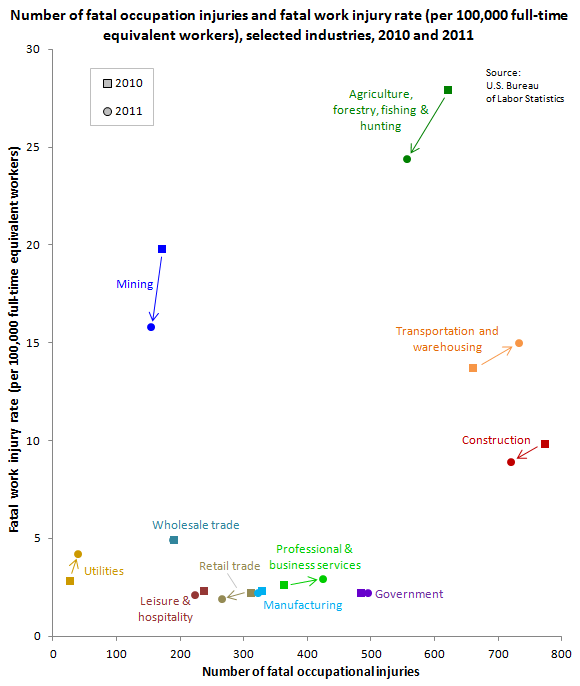September 26, 2012 (The Editor’s Desk is updated each business day.)
Fatal work injuries decrease in construction, increase in transportation and warehousing in 2011
The number of fatal work injuries in the private construction sector declined by 7 percent, from 774 in 2010 to 721 in 2011. The rate of fatal work injury for workers in the private construction industry in 2011 was 8.9 per 100,000 full-time equivalent (FTE) workers, as compared to 9.8 per 100,000 for 2010. The number of fatal work injuries in construction has declined every year since 2006. Construction accounted for the second highest number of fatal work injuries of any industry sector in 2011, after transportation and warehousing.

[Chart data]
Transportation and warehousing accounted for 733 fatal work injuries in 2011, an increase of 11 percent over the final 2010 count (661) and the highest count since 2008. The fatal work injury rate in transportation and warehousing was 15.0 per 100,000 full-time equivalent workers in 2011. The number of fatal injuries in truck transportation increased in 2011, led by increases in general freight trucking and specialized freight trucking. Fatal work injuries in air transportation were lower, but fatal work injuries in water and rail transportation were higher in 2011.
Work-related fatalities in agriculture, forestry, fishing and hunting were down by 10 percent to 557 in 2011 from 621 in 2010, led by a sharp drop in crop production fatalities.
The rate of fatal work injury in agriculture, forestry, fishing and hunting was 24.4 per 100,000 workers in 2011.
Fatal occupational injuries among government workers increased by 2 percent from 2010 to 495; the 2011 fatal work injury rate was 2.2 per 100,000 full-time equivalent workers. Fatalities among local government workers increased in 2011 due to an increase in the number of fatal work injuries in police protection. Fatal work injuries were lower among both state and federal workers.
Fatal work injuries in the professional and business services sector were up 16 percent (from 364 in 2010 to 424 in 2011), with a fatal work injury rate of 2.9 in 2011. The increase was led by an increase in fatal work injuries in landscape services.
The number of manufacturing fatal work injuries (322) was slightly lower in 2011; the fatal work injury rate in manufacturing was 2.2.
Work-related fatalities in the private mining industry (which includes oil and gas extraction) were down 10 percent in 2011 after an increase of 74 percent in 2010. Fatal work injuries in mining numbered 154 in 2011, down from 172 in 2010. The rate of fatal work injury in mining was 15.8 fatal worker injuries per 100,000 FTE workers in 2011, compared with 19.8 the previous year. Fatal work injuries were down sharply in coal mining in 2011.
A preliminary total of 4,609 fatal work injuries were recorded in the United States in 2011, down from a final count of 4,690 fatal work injuries in 2010. The rate of fatal work injury for U.S. workers in 2011 was 3.5 per 100,000 FTE workers, as compared to a final rate of 3.6 for 2010.
These data are from the Census of Fatal Occupational Injuries (CFOI), which is part of the BLS Injuries, Illnesses, and Fatalities program. Data for 2011 are preliminary. Data for 2010 are final. To learn more, see "National Census of Fatal Occupational Injuries in 2011 (Preliminary Results)" (HTML) (PDF) news release USDL-12-1888.
Related TED articles
Industry studies |
Occupational safety and health
Of interest
Spotlight on Statistics: National Hispanic Heritage Month
In this Spotlight, we take a look at the Hispanic labor force—including labor force participation, employment and unemployment, educational attainment, geographic location, country of birth, earnings, consumer expenditures, time use, workplace injuries, and employment projections.
Read more »
